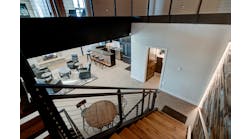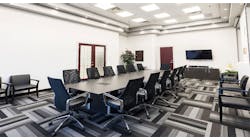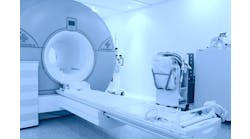In the age of environmental responsibility, building owners are increasingly implementing sustainable construction practices. The $95.6 million Perot Museum of Nature and Science in downtown Dallas, however, goes a step beyond. The 180,000-sq-ft building not only strives to inspire minds with nature and science, but also serves as a living science lesson.
Due to the interactive nature of the museum, the 170-ft-tall, cubed-shaped building is referred to as one of the exhibits, says Erik Kluetz, a field engineer and pre-construction coordinator for Walker Engineering, the electrical contractor on the project.
“The design intent was to make the building as interactive as the exhibits themselves in order to inspire young people to learn more about architecture and engineering,” says Kluetz, whose company served as a design-assist contractor and had a $15-million electrical contract on the job.
For example, a graphical user interface aggregates the building’s energy consumption data into a live, up-to-the-minute dashboard displayed inside the museum. In addition, the color-coded conduit and mechanical pipes and viewing windows peek into mechanical back-of-house areas, and kiosks prompt visitors to learn more about the museum’s sustainable features.
Dubbed as “the building that will launch a million dreams,” the museum is on track to earn LEED gold certification for its energy-efficient lighting, solar water heating, rainwater collection, and building control systems. In the United States, the facility is one of only five projects to receive four Green Globes and is the only Green Globe certified museum.
“Our team is honored to achieve that recognition,” says Chris Wolfe, senior project manager for Balfour Beatty Construction, the general contractor on the project. “We partnered with the architect and sustainability consultant to ensure that our design and construction practices met the program’s requirements.”
Focusing on preplanning. Balfour Beatty Construction not only strived to eliminate waste and focus on sustainability, but also aimed to maximize value. The company selected key industry trade partners to wrap up the job under budget as well as a month ahead of the two-and-a-half-year schedule.
To stay on track, Balfour Beatty Construction and its project partners spent an entire year pre-planning the design and construction of the museum, says David Nicklas, project manager for Walker Engineering, which helped to design and install the electrical power and distribution, exhibit hall lighting, dimming controls, security and fire alarm systems, energy management control system, network cable controls, and network connections.
“Anytime you do a project like this, it’s all about planning,” says Nicklas. “Without a good plan, it doesn’t come together.”
Before the team even began pouring concrete, they spent months in BIM coordination meetings to perform clash detection.
“By building the museum in advance in BIM, we were able to eliminate clashes between trades in the field, and issues were solved in the 3D model, saving the project time and money,” says Wolfe. “It made a huge improvement on such a complicated building and ensured the team delivered a high-quality project.”
Through a structured pre-planning approach called the Mission Alignment Process (MAP), Balfour Beatty Construction pinpointed the owner’s priorities and, when necessary, altered design and construction practices. For example, the project team maintained the building’s aesthetics while driving down the cost of construction by altering the design of the exterior concrete panels. As a result of this revision and many other efficient suggestions from the team, the team members drove down the original conceptual estimate of $1,000 per square foot down to $500 per square foot.
Installing electrical infrastructure. Before erecting the pre-cast exterior concrete panel skin, the MEP trades installed their infrastructure within a waterproof, insulated metal stud wall. The electricians were also tasked with concealing wiring within thick concrete decks. In other cases, the electrical team hid the wiring high in the exhibit space above the grid, which was blacked out to limit visibility.
“We didn’t have a clear riser except for one small space,” Nicklas says. “Because we had limited access from the electrical room to the exhibits to the core walls, it took a lot of coordination to make it all come together.”
The access and layout was crucial when it came to establishing all of the circuit locations, Nicklas says. The atrium stairs rose from the basement up through the fourth floor, and the electricians couldn’t cut across this large open area within the building. To branch the wiring from one side of the atrium to the other, the workers performed a significant amount of underground excavation. In the process, they unearthed a vintage car and an old bridge.
Walker Engineering distributed the 6,000A power service versus a 4,000A vertical bus riser up through the heart of the building to distribute the power for each of the four floor’s exhibit loads, fifth-floor administrative offices and sixth-floor central plant equipment. The remaining 2,000A of service was distributed via conduit and wire risers serving HVAC equipment and emergency generator backup circuits for egress lighting, security, and fire alarm systems. Each floor contains transformers, distribution panels, lighting control panels, and emergency power panels for distribution within the spaces. The total system contained about 150 electrical power and lighting panels located from the basement through the sixth floor central plant.
The museum allocated 5W per sq ft of power and lighting for each exhibit hall. The electricians worked with the designers to install plug-in power sources in the ceiling and floor distribution boxes. In addition, the exhibitors could plug their specialty theatrical lighting into digital dimmer strips mounted overhead on the Unistrut ceiling grid and program their lighting controls using either DMX or IP addressing.
“We gave the exhibitors a lot of flexibility in their spaces so they can move things around as needed,” says Wolfe.
Providing efficient illumination. Walker Engineering also collaborated with the rest of the project team to customize the lighting for the exhibit halls. Throughout the building, electricians installed LED lighting to improve efficiency and drive down long-term maintenance costs. The 11 permanent exhibition halls are lit with LED-based lighting tracks, which are positioned for directional lighting. That way, the museum can relocate and move around the lighting as the layout of the exhibit changes.
“We installed an automated and programmable system for all the galleries so the museum can control the power and lighting and start or shut down an exhibit space one by one,” Nicklas explains. “The track lighting is controlled through all of the lighting controls, and the exhibitors can program their own spaces through a DMX system.”
The electrical team positioned the lighting within the slope on the level one lobby’s rolling wire mesh ceiling for proper illumination. While the house area of the exhibit space is lit by standard LED lighting, special LED fixtures illuminate a temporary traveling dinosaur exhibit in the glass-enclosed lobby and the escalators within a glass-enclosed tube-like structure.
Balfour Beatty Construction also turned to Walker Engineering to find an LED fixture that could provide underhand rail lighting for the atrium staircase. The designers were looking for an even lit strip without any visible pinpoint LEDs, and the company located a viable solution that met the designer’s intent.
By helping to power and illuminate the museum, the electrical team created a center for education, discovery, and exploration in downtown Dallas. At the same time, the project partners were able to create an energy-efficient building that will save on future energy costs, while serving as an example of sustainability.
“It was a one-of-a-kind job to work on,” says Wolfe. “When you walk into the museum and understand the complexities of the project, you feel a great sense of accomplishment for the entire team. Everyone contributed to make it a success.”
Fischbach is a freelance writer based in Overland Park, Kansas. She can be reached at [email protected].
All photos courtesy of Balfour Beatty Construction and Walker Engineering's Erik Kluetz and Kip Kendrick.


